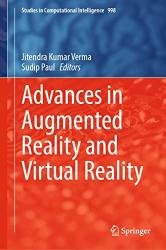 Название: Advances in Augmented Reality and Virtual Reality
Название: Advances in Augmented Reality and Virtual RealityАвтор: Jitendra Kumar Verma, Sudip Paul
Издательство: Springer
Серия: Studies in Computational Intelligence
Год: 2022
Страниц: 220
Язык: английский
Формат: pdf (true), epub
Размер: 46.3 MB
This book gathers the recent advances in Augmented Reality (AR) and Virtual Reality (VR). It includes topics on classification of computer assisted environments, field-of-views on visuospatial memory in complex virtual environment, free-roam VR for gaming, simulation of physical processes in an electric circuit, motion study of mated gears, ternary reversible gates with virtual reality, inclusiveness of AR and VR for agricultural disease detection, application of AR and VR in medical and pharmaceuticals, drones for medical assistance, machine learning based AR technologies for human face detection, recognition, and automated vehicles for medical assistance. The book is targeted towards advancing undergraduate, graduate, and post graduate students, researchers, academicians, policymakers, various government officials, NGOs, and industry research professionals who are currently working in the field of science and technology either directly or indirectly to benefit the common masses.
This book recapitulates and outlines recent advances in computer-assisted environments, particularly those in augmented and virtual reality. While these technologies have been available for a quite some time now, they were mainly confined to research laboratories and science fiction. This book discusses recent advances by focussing upon the application of these technologies in various domains. The book is divided into four parts.
The first part focusses on understanding virtual environments. Chapter “Recreating Reality: Classification of Computer-Assisted Environments” discusses various classifications of computer-assisted environments, namely virtual reality (VR), augmented reality (AR), mixed reality (MR) and extended reality (XR). Chapter “Impact of Different Field-of-Views on Visuospatial Memory and Cognitive Workload in a Complex Virtual Environment” investigates influence of different field of views (FoV) on cognitive performance of the participants in a complex virtual environment. Chapter “Free-Roam Virtual Reality: A New Avenue for Gaming” discusses a business application of perceptions in such virtual environments, by discussing free-roam virtual games.
The second part discusses applications of AR and VR in engineering disciplines. Chapter “Computer Simulation of Physical Processes in an Electric Circuit with Nonlinear Inductance” outlines computer simulation of physical processes in an electric circuit with nonlinear inductance, particularly in the context of laboratory-based teaching and learning. Chapter “A Comparative Motion Study of Mated Gears on AutoCAD and SOLIDWORKS” moves to the discipline of mechanical engineering and presents a comparative motion study of mated gears on AutoCAD and SOLIDWORKS. Chapter “An Overview of Different Approaches for Ternary Reversible Logic Circuits Synthesis Using Ternary Reversible Gates with Special Reference to Virtual Reality” addresses different ternary reversible logic synthesis approaches in logic circuits and highlights its relevance for quantum computing.
The third part turns its gaze towards applications of AR and VR technologies in agriculture and medical fields. Chapter “Tomato’s Disease Identification Using Machine Learning Techniques with the Potential of AR and VR Technologies for Inclusiveness” applies machine learning techniques for tomato’s disease identification, while discussing the potential of AR and VR technologies for inclusiveness. Chapter “Augmented Reality and Virtual Reality Creating Ripple in Medical and Pharmaceutical World” highlights a number of AR and VR applications in the medical field, such as in phantom limb pain management or in the treatment of phobias. Chapter “Autonomous Drones for Medical Assistance Using Reinforcement Learning” focuses on the navigation of autonomous drones for medical assistance by following the bike lanes present on the roads.
The fourth part links AR and VR with another set of technological revolutions by integrating virtual/augmented environments with machine and reinforcement learning approaches. Chapter “Autonomous Navigation of Drones Using Reinforcement Learning” employs reinforcement learning for autonomous navigation of drones. Chapter “Human Face Detection and Recognition Protection System Based on Machine Learning Algorithms with Proposed AR Technology” proposes a human face detection and recognition protection system based on machine learning algorithms. Finally, Chapter “A Reinforcement Learning Approach for Shortest Path Navigation in Automated Guided Vehicles for Medical Assistance” discusses reinforcement learning approach for obstacle detection and shortest path navigation for automated guided vehicles.